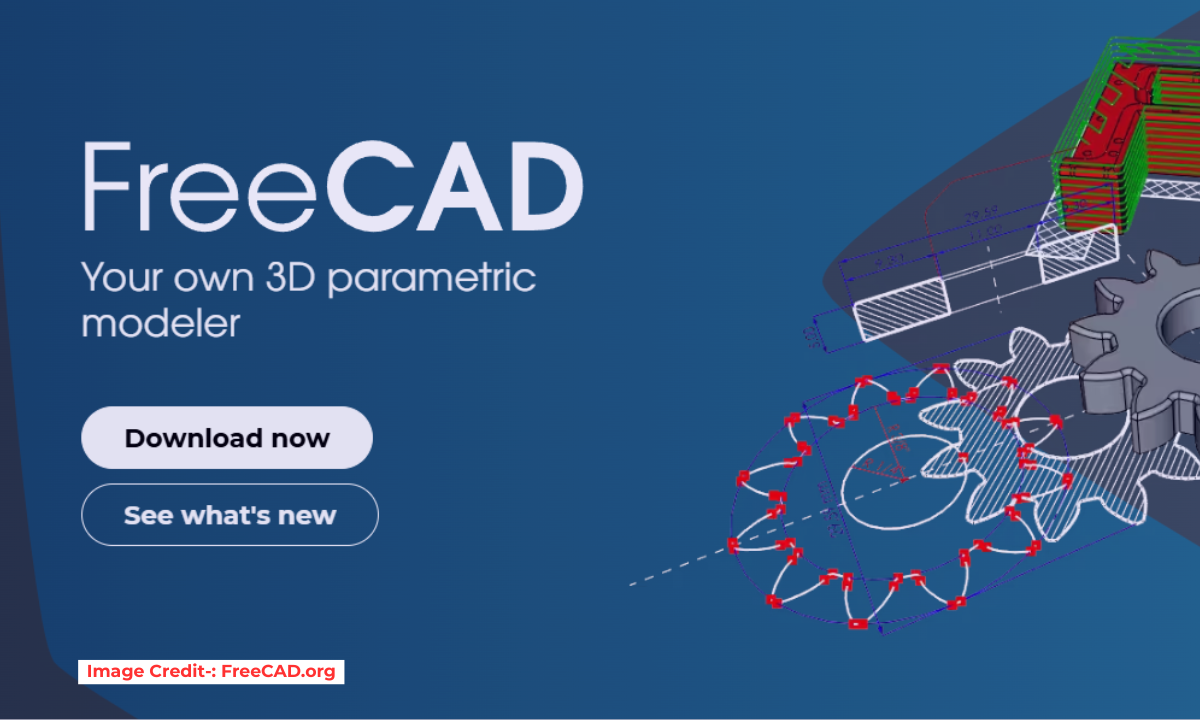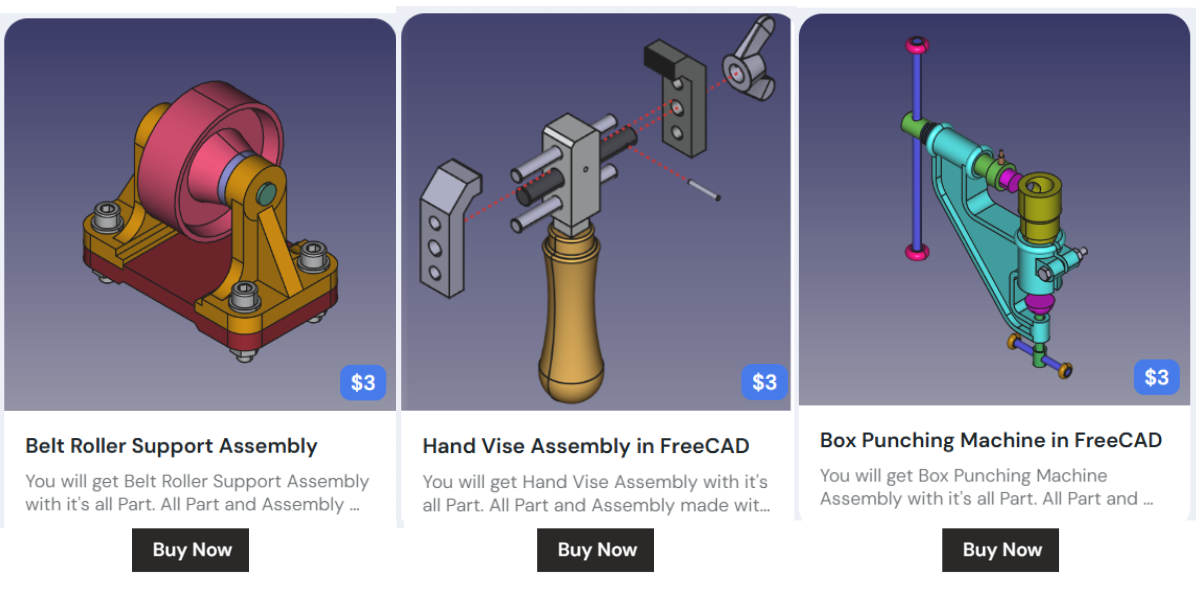
FreeCAD is a general purpose open source parametric 3D CAD modeler licensed under the LGPL License. FreeCAD is aimed directly at mechanical engineering and product design but, being very generic, also fits in a wider range of uses around engineering, such as architecture, finite element analysis, 3D printing, and other tasks.
FreeCAD features tools similar to CATIA, SolidWorks, Solid Edge or Revit, and therefore also falls into the category of CAD, PLM, CAx, CAE and BIM. It is a feature based parametric modeler with a modular software architecture making it possible to provide additional functionality without modifying the core system.
Related Posts:
- Measure Area, Volume & Center of Mass with Python Script
- Import Existing FreeCAD Setting on Fresh FreeCAD Installation
- FreeCAD with Python Scripting. Make Tools and Workflows
As with other CAD modelers it has many 2D components in order to sketch planar shapes or create production drawings. However, direct 2D drawing (like Inkscape or AutoCAD LT) is not the focus, neither are animation or mesh editing (like Blender, Maya, 3ds Max, or Cinema 4D). Nevertheless, thanks to its wide adaptability, FreeCAD is useful in a much broader area around its base feature set.
FreeCAD makes heavy use of open-source libraries that exist in the field of scientific computing. Among them are Open Cascade Technology (OCCT), a powerful CAD kernel; Coin3D, a toolkit for 3D graphics development compatible with Open Inventor; Qt, the world-famous user interface framework; and Python, a modern scripting language. FreeCAD itself can also be used as a library by other programs.
FreeCAD is also multi-platform, and currently runs on Linux/Unix, Windows, and macOS systems with the same look and functionality on all platforms.
For more information about FreeCAD’s capabilities, take a look at the feature list, the latest release notes, and the getting started articles, or see more screenshots.
Here is a summary of its core aspects:
| Feature | Description |
|---|---|
| Primary Use | Mechanical Engineering & Product Design (extensible to other fields like architecture/BIM). |
| Modeling Approach | Parametric Modeling: Models are defined by parameters (e.g., dimensions, constraints) for easy modification and history tracking. |
| Core Technology | Built on the OpenCASCADE geometry kernel, with Qt (GUI), Coin3D (3D visualization), and Python (scripting) as key technologies. |
| Key Architecture | Modular Workbenches: The interface and tools change based on the selected task-specific workbench (e.g., Part Design, Sketcher). |
| License & Cost | Open Source (GPL & LGPL), completely Free. |
🛠️ Understanding Workbenches-:
The workbench system is central to how you interact with FreeCAD. Each workbench provides a specialized set of tools for a specific task. You can switch between workbenches as your workflow demands. Here are some of the most common ones:
| Workbench | Primary Function |
|---|---|
| Sketcher | Creates and manages 2D geometry with geometric and dimensional constraints. |
| Part Design | For part design, used to create solid features (Pad, Pocket, etc.) based on sketches. |
| Part | Offers basic CSG (Constructive Solid Geometry) modeling with primitives and Boolean operations. |
| TechDraw | Generates standard 2D engineering drawings from 3D models. |
| Assembly | Assembles multiple parts into a larger mechanism and can manage interactions. |
| BIM | Dedicated to Building Information Modeling for architectural design. |
| FEM | Provides Finite Element Analysis tools for simulations like stress testing. |
| Draft | Provides 2D drafting tools and basic 3D CAD operations. |
💡 Key Concepts and Getting Started-:
To effectively use FreeCAD, it helps to understand a few foundational concepts and practical tips.
-
Parametric Modeling: This is FreeCAD’s core strength. You define your model using parameters (like a sketch dimension) and features (like an extrusion). Changing a parameter later in the design history automatically updates the entire model, making iterations fast and predictable.
-
Part vs. Part Design: This is a common point of confusion for beginners.
-
The Part Workbench uses a CSG (Constructive Solid Geometry) approach, where you create simple shapes (cubes, cylinders) and combine them using Boolean operations (union, cut).
-
The Part Design Workbench uses a feature-based approach, where you build a single, continuous solid by starting with a sketch and sequentially adding features like pads, pockets, and fillets. For designing complex individual parts, Part Design is often the recommended starting point.
-
-
Python Scripting: Nearly every function in FreeCAD is accessible via Python, allowing you to automate tasks, create custom tools, and even build entire workbenches. This makes FreeCAD highly extensible.
-
Installation and Resources: You can download the stable version of FreeCAD from its official website. Be prepared for a learning curve, as FreeCAD is a powerful tool with its own workflow. Leveraging the official documentation and community forums is highly recommended for new users.
Related Posts:
- Advantages of FreeCAD That Every FreeCAD user Must Know
- Power of FreeCAD: Essential Tools for Mechanical Engineers
- Enhance Design Skills: Essential FreeCAD Tips for Better Creations
About the FreeCAD project-:
The FreeCAD project was started as far back as 2001, as described on the history page.
FreeCAD is maintained and developed by a community of enthusiastic developers and users and is built through the patient work of hundreds of contributors, some regular, some occasional. Most work on FreeCAD as volunteers. The FreeCAD forum is where most of the ideas and decisions are discussed, and the GitHub repository is where the code is being kept, shared, discussed and worked on. Anybody is welcome to participate.
About the FPA-:
The FreeCAD project is also supported by a non-profit organization, the FreeCAD project association (FPA). The FPA is an independent body created by some FreeCAD veterans in 2021 to collect donations and other resources to support the project and its community, to help protect that community and allow it to continue developing in the best conditions, and to represent the project against other bodies such as companies and institutions.
“Thank you for reading! If you found this article insightful and valuable, consider sharing it with your friends and followers on social media. Your share can help others discover this content too. Let’s spread knowledge together. Your support is greatly appreciated!”


